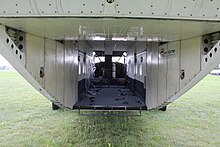Short Skyvan
| Short Skyvan | |
|---|---|
 Short Skyvan SC7 from Helsinki University of Technology |
|
| Type: | Airliner , transport aircraft |
| Design country: | |
| Manufacturer: | |
| First flight: |
17th January 1963 |
| Production time: |
until 1986 |
| Number of pieces: |
153 |


The Short SC7 Skyvan is a twin-engine cargo transport and passenger aircraft from the former British aircraft manufacturer Short Brothers with turboprop engines . The short-haul aircraft designed as a stripped shoulder- wing aircraft with rigid landing gear is not pressurized and can carry a maximum of 1815 kg of cargo or up to 19 passengers. 153 copies were built from 1963 to 1986.
history
At the end of the 1950s, Short Brothers began developing a new twin-engine shoulder- wing aircraft with braced wings as a short take-off and landing (STOL) transport and supply aircraft.
The wings with an unusually large aspect ratio are characteristic . They were based on the research results and developments of the French Hurel-Dubois family of aircraft and gave the machine particularly good STOL properties.
The first flight of the first prototype, the Skyvan SC7 Series 1, took place on January 17, 1963 at Sydenham Airfield in Belfast ; this machine was equipped with piston engines of the Continental GTSIO-520 type, each with an output of 291 kW (396 hp). The second prototype, called Series 1A, was built with Turboméca - Astazou II engines with 382 kW (520 hp) power.
The first series machines were called Skyvan SC7 Series 2 and were equipped with the much more powerful Turboméca-Astazou-XII turboprop engines, each with an output of 485 kW (660 hp). The first flight of a Series 2 aircraft took place on October 29, 1965. From 1968, the Skyvan was equipped with Garrett TPE 331-2-201A propeller turbines with an output of 525 kW (715 hp) each and came out as a Series 3 Market; from September 1970 also optionally as a Series 3A with increased take-off weight.
In addition to the civilian versions, there were also variants for military customers, such as the Skyvan Mk.3M analogous to the Series 3 and the Skyvan Series 3M-200 analogous to the Series 3A. In the 1970s, the Skyliner was also built, a version for airlines that is characterized by more comfortable interior fittings and a side door.
From 1963 to 1986 153 copies of this aircraft were built and, mostly in small numbers, sold to many military and civilian customers worldwide. The most common purpose was or is to carry out material and supply flights, as this aircraft (popularly known as the flying shoebox because of its angular shape ) can also accommodate bulky goods thanks to its large interior. Due to the cross-section of the cabin and the great height of around two meters, you can stand in the interior. Because of this, and also because of the high transport capacity, the Skyvan is still very popular for parachutist drop flights, especially since the large tailgate also enables larger formations to exit.
The Pink Skyvan registered in Austria , which are mainly used in Europe as dropping machines for parachutists, are known above all, not least because of the extremely eye-catching color scheme .
The larger Short 330 (1974, 30 passengers) and Short 360 (1981, 36 passengers) were later developed and used as regional aircraft based on the same basic principles (wings with a large aspect ratio, shoe box shape) .
Military users
-
 Argentina Coast Guard: 5 (lost 2 in the Falklands War ).
Argentina Coast Guard: 5 (lost 2 in the Falklands War ). -
 Botswana
Botswana
-
 Ecuador
Ecuador
-
 Gambia
Gambia
-
 Ghana
Ghana
-
 Guyana
Guyana
-
 Indonesia
Indonesia
-
 Japan : Japanese Coast Guard
Japan : Japanese Coast Guard -
 Yemen
Yemen
-
 Lesotho
Lesotho
-
 Malawi
Malawi
-
 Mauritania
Mauritania
-
 Mexico
Mexico
-
 Nepal
Nepal
-
 Oman ( Air Force ): 16
Oman ( Air Force ): 16 -
 Austria : 2 (1969-2007)
Austria : 2 (1969-2007) -
 Panama
Panama
-
 Singapore ( RSAF )
Singapore ( RSAF ) -
 Thailand : Border Police
Thailand : Border Police -
 United Arab Emirates
United Arab Emirates
-
 United Kingdom : British Army
United Kingdom : British Army
Incidents
From the first flight in 1963 to November 2017, there were 42 total write-offs of aircraft with Skyvan. 104 people were killed in 19 of them.
Technical specifications
| Parameter | Data Short SC7 Skyvan Series 3 |
|---|---|
| crew | 1-2 |
| Passengers | 19th |
| length | 12.22 m |
| span | 19.79 m |
| height | 4.6 m |
| Wing area | 34.65 m² |
| Elongation | 11.3 |
| Wing profile | NACA 63A414 (throughout) |
| Empty mass | 3331 kg |
| Max. Takeoff weight fully fueled | 5670 kg |
| Engines | two propeller turbines Garrett TPE331-2 (each 525 kW / 715 PS) |
| Cruising speed | 325 km / h |
| Service ceiling | 6860 m |
| Range | approx. 1120 km (600 nm) with a tank volume of 1080 l |
See also
Web links
Individual evidence
- ↑ Air-Britain Aviation World , March 2015, p. 9 ( English )
- ↑ Air-Britain Aviation World , March 2015, p. 8 ( English )
- ↑ "Short SC.7 Skyvan Picture." ( Page no longer available , search in web archives ) Info: The link was automatically marked as defective. Please check the link according to the instructions and then remove this notice. facebook.com. Retrieved January 8, 2012.
- ↑ Hoyle 2011, p. 40.
- ↑ Hoyle 2011, p. 45.
- ↑ Taylor 1982, p. 271.
- ↑ GoTech
- ↑ Accident statistics Shorts Skyvan , Aviation Safety Network (English), accessed on December 17, 2017.




